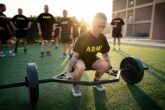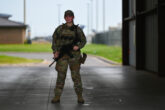August 01, 2024
The Military Needs to Make Human-Performance Optimization Part of Daily Ops
Ukraine’s fierce defense against Russia’s better-on-paper invasion force underscores—once again—how soldiers represent human weapons systems, bringing cognitive, physical, and tactical attributes to the mission in ways that technology still cannot replicate. But while the U.S. military has long valued physical fitness, it has been slow to pursue a fuller range of efforts to optimize human performance. Now Congress is getting involved, mulling a trio of legislative proposals, and the Pentagon should do more besides.
To be sure, the special operations community has long viewed operators as “tactical athletes,” and recent years have seen conventional forces join in; examples include the Army’s Holistic Health and Fitness program and the Air Force Research Lab’s human performance program.
Given the future operating environment, the military can no longer only view human performance through the lens of daily physical training requirements.
But more can be done—and should be. A human performance optimization framework is essential for operation in the Pacific theater, particularly among ground operators. A conflict with the China would require small teams of stand-in forces to operate with a light footprint and signature to remain undetectable, requiring a certain level of self-reliance away from consistent logistics hubs, in a communications-degraded environment, and outside the reach of medical evacuation within the golden hour. Casualties in such environments not only put the lives of individual service members at risk; they put the entire joint force mission at risk. Under such conditions, it won’t be enough for the service members to be trained and equipped to avoid injury. The services will need to optimize the performance of every individual assigned to the theater.
DOD has traditionally been averse to experimentation with “human weapons systems”—and for good reason. Experimentation with machines typically follows a linear path: the introduction of a new material or parameter can be tested, and the decision to incorporate or reject such a change depends on performance in testing. But human beings are not machines, and the impact of interventions is more cyclical. Human beings require recovery periods and consistent monitoring. Most importantly, no service wants to learn about human performance at the cost of permanent injury or death.
Read the full article from Defense One.
More from CNAS
-
National Security Human Capital Program
Short SupplyExecutive Summary The U.S. military faces a critical challenge: Fewer young Americans are willing to serve, and fewer adults are encouraging them to do so. Because of delibera...
By Katherine L. Kuzminski & Taren Sylvester
-
National Security Human Capital Program
Defending the Army’s Command Assessment ProgramThe concept for CAP — developed during the first Trump administration — benefited from the guidance, input and oversight from the foremost scholar and practitioner on military...
By Katherine L. Kuzminski
-
National Security Human Capital Program
‘Women Don’t Just Achieve…They Excel’: Fmr. Marine Corps Attack PilotDr. Kyleanne Hunter, former Marine Corps attack pilot and CEO of Iraq & Afghanistan Veterans of America, says “women are the fastest growing group of veterans” and “the fastes...
By Dr. Kyleanne Hunter
-
National Security Human Capital Program
A Workforce Strategy for America’s Shipbuilding FutureThe future of American maritime dominance will not be determined solely by the number of ships launched or contracts signed, but rather by the strength and sustainability of t...
By Katherine L. Kuzminski & Laura Schmiegel




